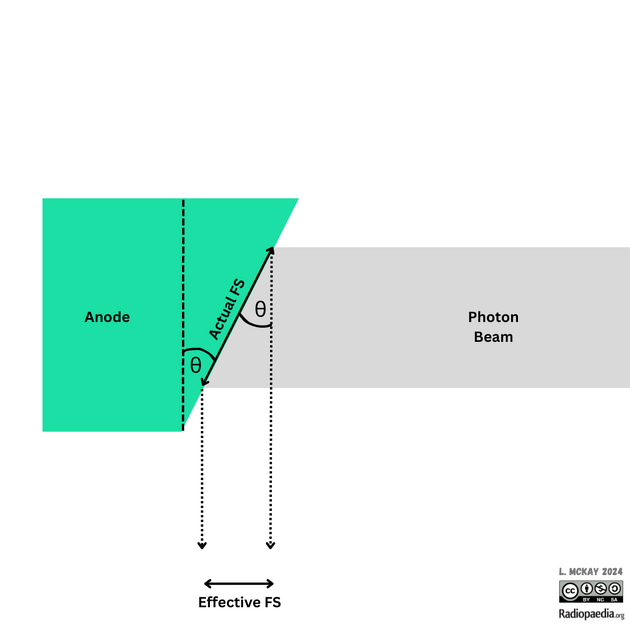The line focus principle in radiography explains the relationship between the actual focal spot on the anode surface and the effective focal spot size.
Basic concept
The focal spot is the area of the target upon which the electron beam strikes. The energy of the electrons in the electron beam is mostly converted into heat (approximately 99%, which is why materials such as tungsten are used due to their high melting-points) and dissipated uniformly across the focal spot and anode surface. The x-rays produced at the anode comprise less than one percent of the energy of the electrons in the electron beam.
A large focal spot is therefore useful to protect the tungsten target as the heat accumulates and dissipates within the larger area of focal spot when compared to a small focal spot. However, a small focal spot is required to achieve good radiographic image quality.
The line focus principle describes the effect of the angulation of anode surface on the area of the effective focal spot size (or field of view). The larger the anode angle, the larger the effective focal spot size and vice versa.
The line focus principle describes two focal spots; an actual focal spot, the area of the anode surface struck by the electron beam, and the effective focal spot, which is the area of the x-ray beam as it's directed towards the patient.
The effective focal spot size can be determined by the sine of the angle of the anode surface (effective focal spot size = actual focal spot size * sin anode angle). The angle varies as per tube design with a range value of 6 degrees to about 20 degrees.
As the anode angle changes, only the effective focal spot changes in size. The actual focal spot size will remain the same. Therefore, a change in the anode angle will not influence the heat capacity of the anode as the actual focal spot remains unchanged. Actual focal spot is the area on the anode struck by the electron beam, that determines heat capacity 2.
Limitation of the principle
For a smaller target angle, the field of view covered by the x-ray beam will be smaller so it is not possible to cover large areas at smaller focus film distances (FFDs). Therefore, it can be appreciated that choice of target angle is a compromise between geometric unsharpness and desired field of view. For practical purpose, at 40" FFD the anode angle should be no smaller than 15 degrees. A decrease in angle below six degrees will result in anode heel effect.





 Unable to process the form. Check for errors and try again.
Unable to process the form. Check for errors and try again.